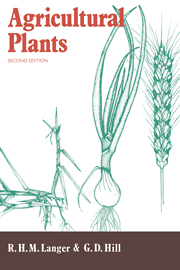Book contents
- Frontmatter
- Contents
- Preface to the first edition
- Preface to the second edition
- 1 World population and crop production
- 2 Plant structure
- 3 Liliaceae
- 4 Poaceae
- 5 Apiaceae
- 6 Asteraceae
- 7 Brassicaceae
- 8 Cannabinaceae
- 9 Chenopodiaceae
- 10 Cucurbitaceae
- 11 Fabaceae
- 12 Lamiaceae
- 13 Linaceae
- 14 Malvaceae
- 15 Papaveraceae
- 16 Solanaceae
- 17 Physiological basis of yield
- Index of specific names
- Subject index
3 - Liliaceae
Published online by Cambridge University Press: 05 June 2012
- Frontmatter
- Contents
- Preface to the first edition
- Preface to the second edition
- 1 World population and crop production
- 2 Plant structure
- 3 Liliaceae
- 4 Poaceae
- 5 Apiaceae
- 6 Asteraceae
- 7 Brassicaceae
- 8 Cannabinaceae
- 9 Chenopodiaceae
- 10 Cucurbitaceae
- 11 Fabaceae
- 12 Lamiaceae
- 13 Linaceae
- 14 Malvaceae
- 15 Papaveraceae
- 16 Solanaceae
- 17 Physiological basis of yield
- Index of specific names
- Subject index
Summary
There are a number of minor crop plants derived from this plant family. Apart from asparagus they are mainly grown for the flavour that they impart to our food rather than as a main part of our diet. There has been some argument amongst taxonomists as to the correct placement of the genus Allium and it is sometimes placed among the Alliaceae; however here it will be considered in its more traditional location as a member of the Liliaceae.
ALLIUM
Three important temperate agricultural crops belong to this genus. They are cultivated mainly for their pungent flavour and the harvested crop usually comprises fleshy leaf bases which are formed into bulbs in the case of onion (Allium cepa) and garlic (A. sativum) or a tightly rolled pseudostem in the leek (A. ameloprasum). A commonly cultivated garden herb is A. schoenoprasum, or chives, whose fine mild-flavoured leaves are used in a wide range of food preparations. Some members of the genus are also weeds of pasture. The problem they cause is not their aggressive properties as plants but the sulphur compounds they contain which give them their pungent aroma. The milk produced by cows grazing these pastures becomes tainted with a garlic-like flavour and has to be sold at a lower price.
Onion (Allium cepa)
Origin
The common onion is thought to have originated in the mountain lands of central Asia where Afghanistan, Iran and Pakistan meet.
- Type
- Chapter
- Information
- Agricultural Plants , pp. 33 - 39Publisher: Cambridge University PressPrint publication year: 1991



